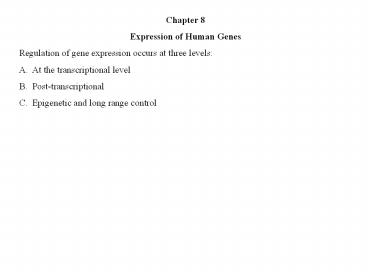Expression of Human Genes - PowerPoint PPT Presentation
1 / 29
Title:
Expression of Human Genes
Description:
A. Control of gene expression by binding of trans-acting protein ... 2. The helix-loop-helix motif. 3. The helix-turn-helix motif. 4. The zinc finger motif ... – PowerPoint PPT presentation
Number of Views:42
Avg rating:3.0/5.0
Title: Expression of Human Genes
1
Chapter 8 Expression of Human Genes Regulation of
gene expression occurs at three levels A. At
the transcriptional level B. Post-transcriptional
C. Epigenetic and long range control
2
- A. Control of gene expression by binding of
trans-acting protein factors to cis-acting
regulatory sequences in DNA and RNA - Control by DNA-binding proteins
- Control by RNA-binding proteins
3
- 1. Ubiquitous transcription factors are required
for transcription by RNA polymerase I and III - Requirements for transcription by RNA
polymerase I (18S, 5.8S and 28S RNA) - Requirements for transcription by RNA
polymerase III (tRNA and 5S RNA)
4
(No Transcript)
5
(No Transcript)
6
(No Transcript)
7
- 2. Transcription of polypetide-coding genes
require a set of cis-acting elements and tissue-
and developmental-specific transcription factors - RNA polymerase II is responsible for
transcribing protein-coding genes and certain
snRNA genes.
8
(No Transcript)
9
(No Transcript)
10
(No Transcript)
11
- 3. Transcription factors contain conserved
structural motifs that permit DNA binding - Transcription factors for humans have two
distinct functions - An activation domain
- A DNA-binding domain
12
Four types of transcription factors 1. The
leucine zipper motif 2. The helix-loop-helix
motif 3. The helix-turn-helix motif 4. The zinc
finger motif
13
(No Transcript)
14
(No Transcript)
15
4. Several mechanisms permit transcriptional
regulation of gene expression in reponse to
external stimuli (a) Ligand-inducible
transcription factors (for small hydrophobic
hormones such as steroid which diffuse through
plasma membrane) Transcription factors (often
known as hormone nuclear receptors) are activated
by binding to a ligand then bind to a response
element located in the promoter regions of about
50-100 target genes and activates their
transcription. The hormone nuclear receptors are
characterized by two conserved domains - a DNA
binding domain (68 amino acid long). It contains
zinc fingers and binds to DNA as a dimer. - a
ligand binding domain (240 amino acid)
16
(No Transcript)
17
(No Transcript)
18
(b) Activation of transcription factors by
signal transduction For hydrophilic signaling
molecules that cannot diffuse through plasma
membrane. Instead they bind to a specific
receptor. Two genral mechanisms permit
transmission of signals from cell-surface
receptors to the nucleus -i- Protein kinases
are activated then translocated from the
cytoplasm to the nucleus where they phosphorylate
target transcription factors. E.g. hormonal
signaling through cyclic AMP pathway -ii-
Inactive transcription factors stored in the
cytoplasm are activated by phosphorylation and
translocated into the nucleus. E.g. activation of
NF-kB via protein kinase C signaling
19
(No Transcript)
20
5. Translational control of gene expression can
involve specific recognition by RNA-binding
proteins of regulatory sequences within the
untranslated sequences of RNA Several cis-acting
regulatory elements, mostly are bound by
trans-acting RNA-binding proteins and regulate at
the translational level in three ways -i-
intracellular RNA localization -ii-
translational control of gene expression in
response to external stimuli. E.g. The
IRE-binding protein regulates the production of
ferritin heavy chain and transferrin receptor by
binding to iron-response elements (IREs) in the
5- or 3-untranslated regions. -iii-
translational control of gene expression of gene
expression during early development. Upon
fertilization no new mRNA is transcribed until
the 4-8 cell stage and regulation occurs at the
translational level for maternal mRNA synthesized
during oogenesis.
21
(No Transcript)
22
- B. Alternative transcription and processing of
individual genes - 1. Transcription of a single human gene can be
initiated from a variety of alternative promoters
and can result in a variety of tissue-specific
isoforms. This results in - Tissue-specificity e.g. dystrophin gene
- Developmental stage-specificity e.g. the
insulin-like growth factor II gene - Differential subcellular localization e.g.
soluble and mebrane-bound isoforms - Differential functional capacity e.g. the
progesterone receptor - Sex-specific gene regulation the Dnmt1
methyltransferase gene
23
(No Transcript)
24
2. Human genes often encode more than one
product as a result of alternative splicing and
alternative polyadenylation events. E.g. -i-
Differential splicing in the WT1 Wilms tumor
gene -ii- Alternative polyadenylation of the
calcitonin gene results in tissue-specific
products
25
(No Transcript)
26
(No Transcript)
27
3. RNA editing is a rare form of
post-transcriptional processing whereby
base-specific changes are enzymatically
introduced at the RNA level. Types of RNA
editing in humans (i) C---gt U, occurs in humans
by a specific cytosine deaminase e.g. The
expression of the human apolipoprotein B gene in
the intestine involves tissue-specific RNA
editing (ii) A ---gt I, the amino group in in
carbon 6 of adenine is replaced by a carbonyl
group. I then acts as a G. Occurs in some
ligand-gated ion channels. (iii) U ---gt C, in
mRNA of the WT1 Wilms tumor gene (iv) U ---gt A,
in alpha-galactosidase mRNA
28
(No Transcript)
29
(No Transcript)































